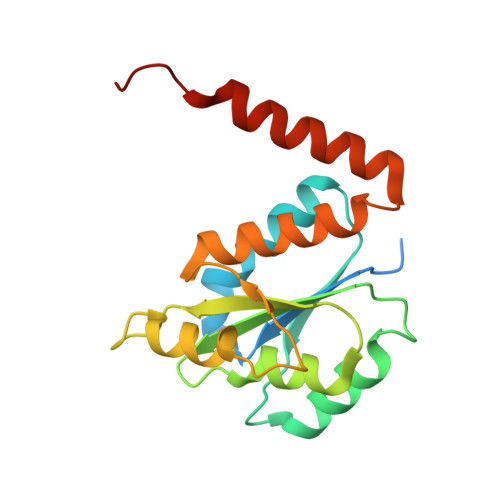Biochemical and Structural Studies of N(5)-Carboxyaminoimidazole Ribonucleotide Mutase from the Acidophilic Bacterium Acetobacter aceti.
Constantine, C.Z., Starks, C.M., Mill, C.P., Ransome, A.E., Karpowicz, S.J., Francois, J.A., Goodman, R.A., Kappock, T.J.(2006) Biochemistry 45: 8193-8208
- PubMed: 16819818
- DOI: https://doi.org/10.1021/bi060465n
- Primary Citation of Related Structures:
2FW1, 2FW6, 2FW7, 2FW8, 2FW9, 2FWA, 2FWB, 2FWI, 2FWJ, 2FWP - PubMed Abstract:
N5-carboxyaminoimidazole ribonucleotide (N5-CAIR) mutase (PurE) catalyzes the reversible interconversion of acid-labile compounds N5-CAIR and 4-carboxy-5-aminoimidazole ribonucleotide (CAIR). We have examined PurE from the acidophilic bacterium Acetobacter aceti (AaPurE), focusing on its adaptation to acid pH and the roles of conserved residues His59 and His89. Both AaPurE and Escherichia coli PurE showed quasi-reversible acid-mediated inactivation, but wt AaPurE was much more stable at pH 3.5, with a > or = 20 degrees C higher thermal unfolding temperature at all pHs. His89 is not essential and does not function as part of a proton relay system. The kcat pH-rate profile was consistent with the assignment of pK1 to unproductive protonation of bound nucleotide and pK2 to deprotonation of His59. A 1.85 A resolution crystal structure of the inactive mutant H59N-AaPurE soaked in CAIR showed that protonation of CAIR C4 can occur in the absence of His59. The resulting species, modeled as isoCAIR [4(R)-carboxy-5-iminoimidazoline ribonucleotide], is strongly stabilized by extensive interactions with the enzyme and a water molecule. The carboxylate moiety is positioned in a small pocket proposed to facilitate nucleotide decarboxylation in the forward direction (N5-CAIR --> CAIR) [Meyer, E., Kappock, T. J., Osuji, C., and Stubbe, J. (1999) Biochemistry 38, 3012-3018]. Comparisons with model studies suggest that in the reverse (nonbiosynthetic) direction PurE favors protonation of CAIR C4. We suggest that the essential role of protonated His59 is to lower the barrier to decarboxylation by stabilizing a CO2-azaenolate intermediate.
Organizational Affiliation:
Department of Chemistry, Washington University, St. Louis, Missouri 63130-4899, USA.















